Sensitivity and Efficiency of the Frequency Shift Coefficient Based on the Damage Identification Algorithm: Modeling Uncertainty on Natural Frequencies
Abstract
:1. Introduction
2. Beam Vibration Theory
2.1. 2D Finite Element Models of Beam
2.2. Numerical Modeling of Damage
3. Proposed Damage Identification Strategy
3.1. Objective Function
3.2. Proposed Strategy and Minimization Problem
3.3. Steps for Damage Identification Procedure
3.4. Modeling Uncertainty on Natural Frequencies
4. Numerical Validation of Method
4.1. Numerical Beam Model
4.2. Localization and Quantification of Single Damage
4.3. Localization and Quantification of Double Damages
4.4. In the Case of Modeling Uncertainty on Natural Frequencies
5. Experimental Example for Damage Identification
Results
6. Conclusions
Author Contributions
Funding
Data Availability Statement
Acknowledgments
Conflicts of Interest
References
- Dai, D.; He, Q. Structure damage localization with ultrasonic guided waves based on a time–frequency method. J. Signal Process. 2014, 96, 21–28. [Google Scholar] [CrossRef]
- Clarke, T.; Simonetti, F.; Cawley, P. Guided wave health monitoring of complex structures by sparse array systems: Influence of temperature changes on performance. J. Sound Vib. 2010, 329, 2306–2322. [Google Scholar] [CrossRef]
- Sodano, H.A. Development of an automated eddy current structural health monitoring technique with an extended sensing region for corrosion detection. Struct. Health Monit. 2007, 6, 111–119. [Google Scholar] [CrossRef]
- Bruno, C.L.E.; Gliozzi, A.S.; Scalerandi, M.; Antonaci, P. Analysis of elastic nonlinearity using the scaling subtraction method. Phys. Rev. B 2009, 79, 064108. [Google Scholar] [CrossRef]
- Loi, G.; Porcu, M.C.; Aymerich, F. Impact damage detection in composite beams by analysis of non-linearity under pulse excitation. J. Compos. Sci. 2021, 5, 39. [Google Scholar] [CrossRef]
- Frau, A.; Pieczonka, L.; Porcu, M.C.; Staszewski, W.J.; Aymerich, F. Analysis of elastic nonlinearity for impact damage detection in composite laminates. J. Phys. Conf. Ser. 2015, 628, 012103. [Google Scholar] [CrossRef]
- Messina, A.; Jones, I.; Williams, E. Damage detection and localization using natural frequency changes. In Proceedings of the Conference on Identification in Engineering Systems, Cambridge, UK, 1 March 1996; pp. 67–76. [Google Scholar]
- Messina, A.; Williams, E.; Contursi, T. Structural damage detection by a sensitivity and statistical-based method. J. Sound Vib. 1998, 216, 791–808. [Google Scholar] [CrossRef]
- Pandey, A.; Biswas, M.; Samman, M. Damage detection from changes in curvature mode shapes. J. Sound Vib. 1991, 145, 321–332. [Google Scholar] [CrossRef]
- Pandey, A.; Biswas, M. Damage detection in structures using changes in flexibility. J. Sound Vib. 1994, 169, 3–17. [Google Scholar] [CrossRef]
- Doebling, S.W.; Farrar, C.R.; Prime, M.B.; Shevitz, D.W. Damage Identification and Health Monitoring of Structural and Mechanical Systems from Changes in Their Vibration Characteristics: A Literature Review; Technical Report; Los Alamos National Laboratory: Los Alamos, NM, USA, 1996. [Google Scholar] [CrossRef] [Green Version]
- Rytter, A. Vibrational Based Inspection of Civil Engineering Structures. Ph.D. Thesis, Department of Building Technology and Structural Engineering, Aalborg University, Aalborg, Denmark, 1993. [Google Scholar]
- Dubey, A.; Denis, V.; Serra, R. A novel VBSHM strategy to identify geometrical damage properties using only frequency changes and damage library. Appl. Sci. 2020, 10, 8717. [Google Scholar] [CrossRef]
- Huang, M.S.; Gül, M.; Zhu, H.P. Vibration-based structural damage identification under varying temperature effects. J. Aerosp. Eng. 2018, 31, 04018014. [Google Scholar] [CrossRef]
- Wang, Z.; Huang, M.; Gu, J. Temperature effects on vibration-based damage detection of a reinforced concrete slab. Appl. Sci. 2020, 10, 2869. [Google Scholar] [CrossRef] [Green Version]
- Toh, G.; Park, J. Review of vibration based structural health monitoring using deep learning. Appl. Sci. 2020, 10, 1680. [Google Scholar] [CrossRef]
- Salawu, O. Detection of structural damage though changes in frequency: A review. Eng. Struct. 1997, 19, 718–723. [Google Scholar] [CrossRef]
- Cawley, P.; Adams, R.D. The location of defects in structures from measurements of natural frequencies. J. Strain Anal. Eng. Des. 1979, 14, 49–57. [Google Scholar] [CrossRef]
- Narkis, Y. Identification of crack location in vibrating simply supported beams. J. Sound Vib. 1994, 172, 549–558. [Google Scholar] [CrossRef]
- Silva, M.E.; Araujo Gomes, A. Crack identification on simple structural elements through the use of natural frequency variations: The inverse problem. In Proceedings of the 12th International Modal Analysis, Honolulu, HI, USA, 31 January–3 February 1994; pp. 1728–1735. [Google Scholar]
- Brincker, R.; Andersen, P.; Kirkegaard, P.H.; Ulfkjaer, J. Damage detection in laboratory concrete beams. In Proceedings of the 13th International Modal Analysis Conference, Nashville, TN, USA, 13–16 February 1995; pp. 668–674. [Google Scholar]
- Kim, J.-T.; Ryu, Y.-S.; Cho, H.-M.; Stubbs, N. Damage identification in beam-type structures: Frequency-based method vs mode-shape-based method. Eng. Struct. 2003, 25, 57–67. [Google Scholar] [CrossRef]
- Armon, D.; Ben-Haim, Y.; Braun, S. Crack detection in beams by rankordering of eigenfrequency shifts. Mech. Syst. Signal Process. 1994, 8, 81–91. [Google Scholar] [CrossRef]
- Zhang, Y.; Lie, S.T.; Xiang, Z.; Lu, Q. A frequency shift curve based damage detection method for cylindrical shell structures. J. Sound Vib. 2014, 333, 1671–1683. [Google Scholar] [CrossRef]
- Gillich, G.R.; Ntakpe, J.L.; Wahab, M.A.; Praisach, Z.I.; Mimis, M.C. Damage detection in multi-span beams based on the analysis of frequency changes. J. Phys. Conf. Ser. 2017, 842, 012033. [Google Scholar] [CrossRef] [Green Version]
- Shukla, A.; Harsha, S. Vibration response analysis of last stage lp turbine blades for variable size of crack in root. Procedia Technol. 2016, 23, 232–239. [Google Scholar] [CrossRef] [Green Version]
- Keye, S. Improving the performance of model-based damage detection methods through the use of an updated analytical model. Aerosp. Sci. Technol. 2006, 10, 199–206. [Google Scholar] [CrossRef]
- Gautier, G.; Mencik, J.M.; Serra, R. A finite element-based subspace fitting approach for structure identification and damage localization. Mech. Syst. Signal Process. 2015, 58, 143–159. [Google Scholar] [CrossRef]
- Dahak, M.; Touat, N.; Benseddiq, N. On the classification of normalized natural frequencies for damage detection in cantilever beam. J. Sound Vib. 2017, 402, 70–84. [Google Scholar] [CrossRef]
- Khiem, N.; Toan, L. A novel method for crack detection in beam-like structures by measurements of natural frequencies. J. Sound Vib. 2014, 333, 4084–4103. [Google Scholar] [CrossRef]
- Le, T.-T.-H.; Point, N.; Argoul, P.; Cumunel, G. Structural changes assessment in axial stressed beams through frequencies variation. Int. J. Mech. Sci. 2016, 110, 41–52. [Google Scholar] [CrossRef]
- Khatir, S.; Belaidi, I.; Serra, R.; Wahab, M.A.; Khatir, T. Damage detection and localization in composite beam structures based on vibration analysis. Mechanics 2015, 21, 472–479. [Google Scholar] [CrossRef] [Green Version]
- Yam, L.H.; Li, Y.Y.; Wong, W.O. Sensitivity studies of parameters for damage detection of plate-like structures using static and dynamic approaches. Eng. Struct. 2002, 24, 1465–1475. [Google Scholar] [CrossRef]
- Serra, R.; Lopez, L.; Gautier, G. Tentative of damage estimation for different damage scenarios on cantilever beam using numerical library. In Proceedings of the 23th International Congress on Sound and Vibration, Athens, Greece, 10–14 July 2016; pp. 10–14. [Google Scholar]
- Eraky, A.; Anwar, A.M.; Saad, A.; Abdo, A. Damage detection of flexural structural systems using damage index method–experimental approach. Alex. Eng. J. 2015, 54, 497–507. [Google Scholar] [CrossRef]
- Serra, R.; Lopez, L. Damage detection methodology on beam-like structures based on combined modal wavelet transform strategy. Mech. Ind. 2017, 18, 807. [Google Scholar] [CrossRef] [Green Version]
- Hu, W.H.; Thöns, S.; Rohrmann, R.G.; Said, S.; Rücker, W. Vibration-based structural health monitoring of a wind turbine system Part II: Environmental/operational effects on dynamic properties. Eng. Struct. 2015, 89, 273–290. [Google Scholar] [CrossRef]
- Karbhari, V.; Lee, L.S.-W. Vibration-based damage detection techniques for structural health monitoring of civil infrastructure systems. In Struct. Health Monit. Civ. Infrastruct. Syst.; Karbhari, V.M., Ansari, F., Eds.; Woodhead Publishing Limited: Cambridge, UK, 2009; pp. 177–212. [Google Scholar] [CrossRef]
- Porcu, M.C.; Patteri, D.M.; Melis, S.; Aymerich, F. Effectiveness of the FRF curvature technique for structural health monitoring. Constr. Build. Mater. 2019, 226, 173–187. [Google Scholar] [CrossRef]
- Furukawa, A.; Kiyono, J. Identification of structural damage based on vibration responses. In Proceedings of the 13th World Conference on Earthquake Engineering, Vancouver, BC, Canada, 1–6 August 2004. [Google Scholar]
- Mohan, S.; Maiti, D.K.; Maity, D. Structural damage assessment using frequency response function employing particle swarm optimization. Appl. Math. Comput. 2013, 219, 10387–10400. [Google Scholar] [CrossRef]
- Huang, M.; Lei, Y.; Li, X. Structural damage identification based on l1 regularization and bare bones particle swarm optimization with double jump strategy. Math. Probl. Eng. 2019, 5954104. [Google Scholar] [CrossRef] [Green Version]
- Li, X.L.; Serra, R.; Olivier, J. Performance of fitness functions based on natural frequencies in defect detection using the standard PSO-FEM approach. Shock Vib. 2021, 8863107. [Google Scholar] [CrossRef]
- Li, X.L.; Serra, R.; Olivier, J. A multi-component PSO algorithm with leader learning mechanism for structural damage detection. Appl. Soft Comput. 2021, 116, 108315. [Google Scholar] [CrossRef]
- Alamdari, M.M.; Li, J.; Samali, B. Damage identification using 2-d discrete wavelet transform on extended operational mode shapes. Arch. Civ. Mech. Eng. 2015, 15, 698–710. [Google Scholar] [CrossRef]
- Kennedy, J.; Eberhart, R. Particle swarm optimization. In Proceedings of the ICNN’95-International Conference on Neural Networks, Perth, Australia, 27 November–1 December 1995; Volume 4, pp. 1942–1948. [Google Scholar]
- Kouroussis, G.; Fekih, L.B.; Conti, C.; Verlinden, O. Easymod: A matlab/scilab toolbox for teaching modal analysis. In Proceedings of the 19th International Congress on Sound and Vibration, Vilnius, Lithuania, 8–12 July 2012. [Google Scholar]
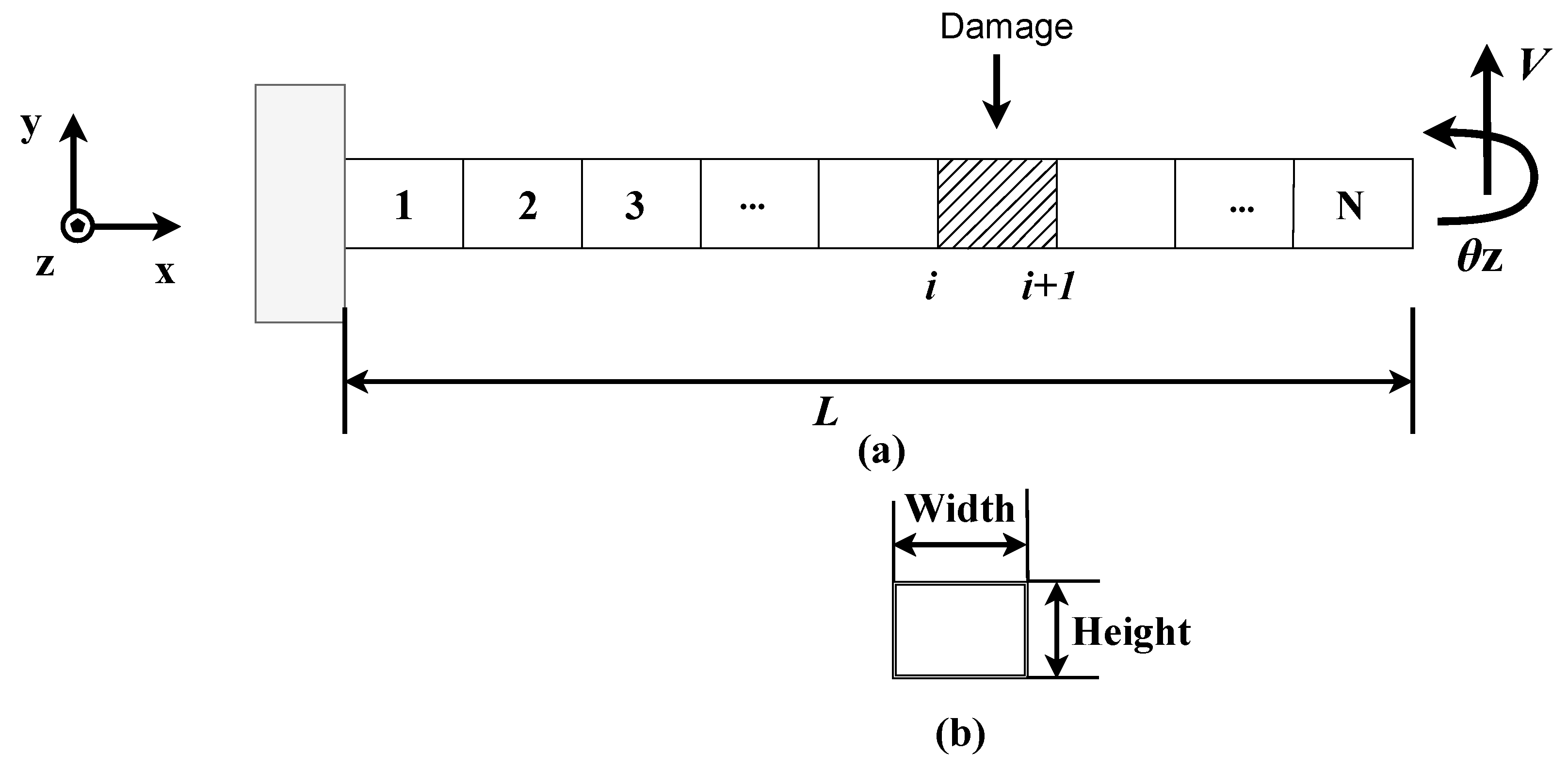
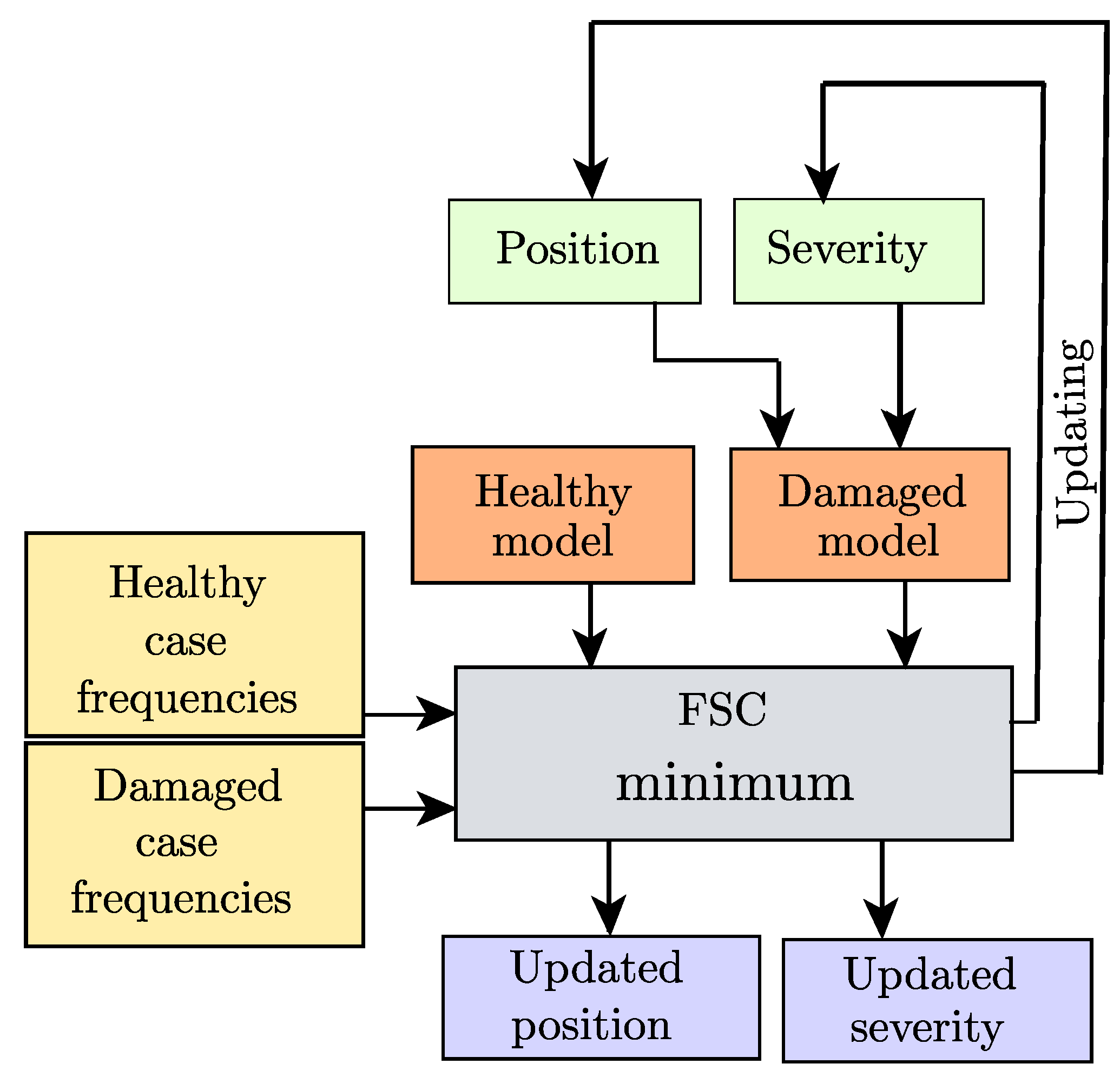
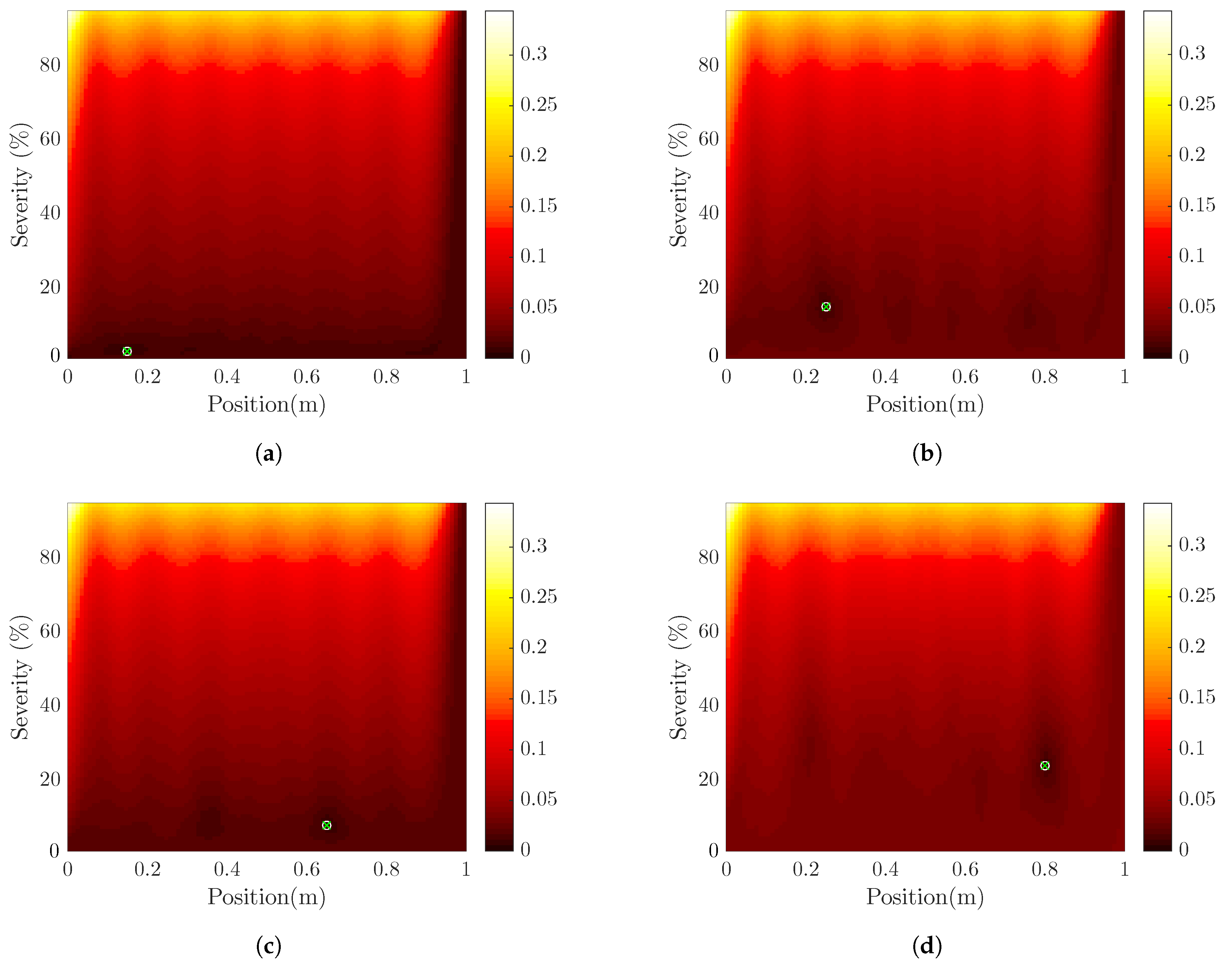
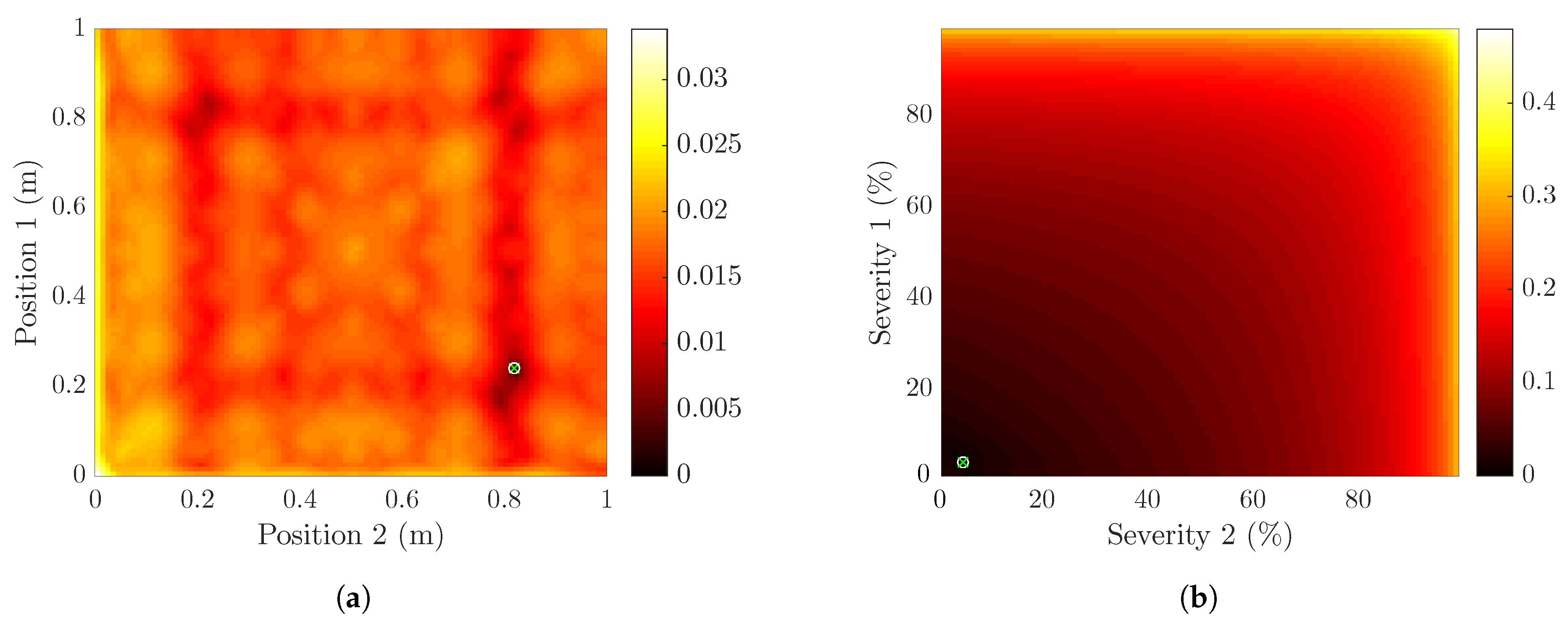
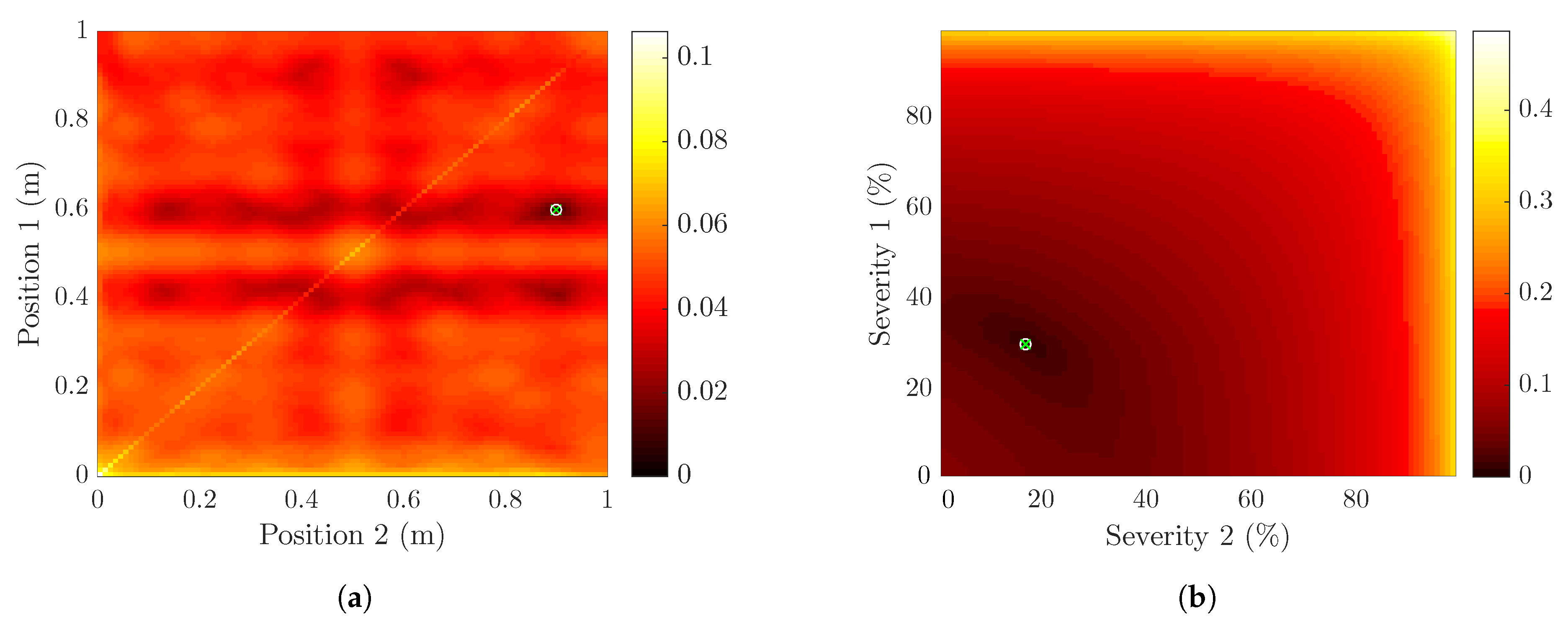
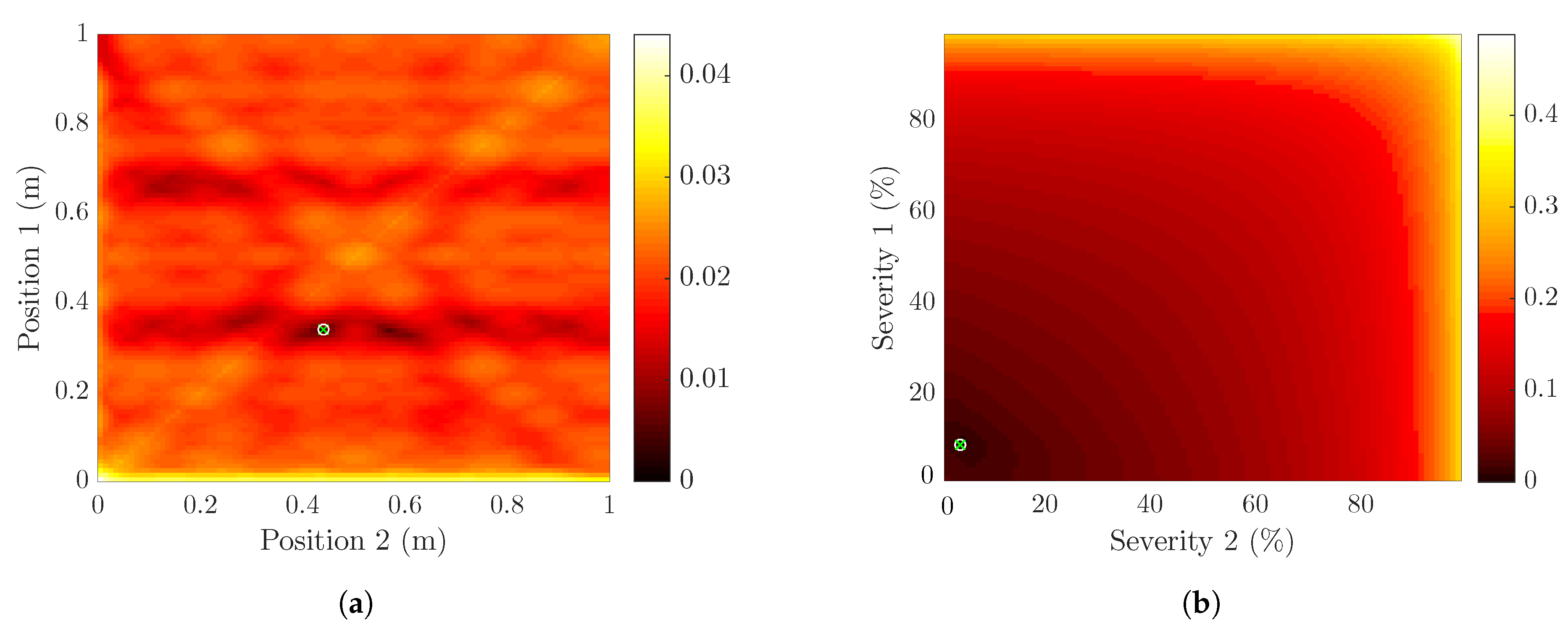
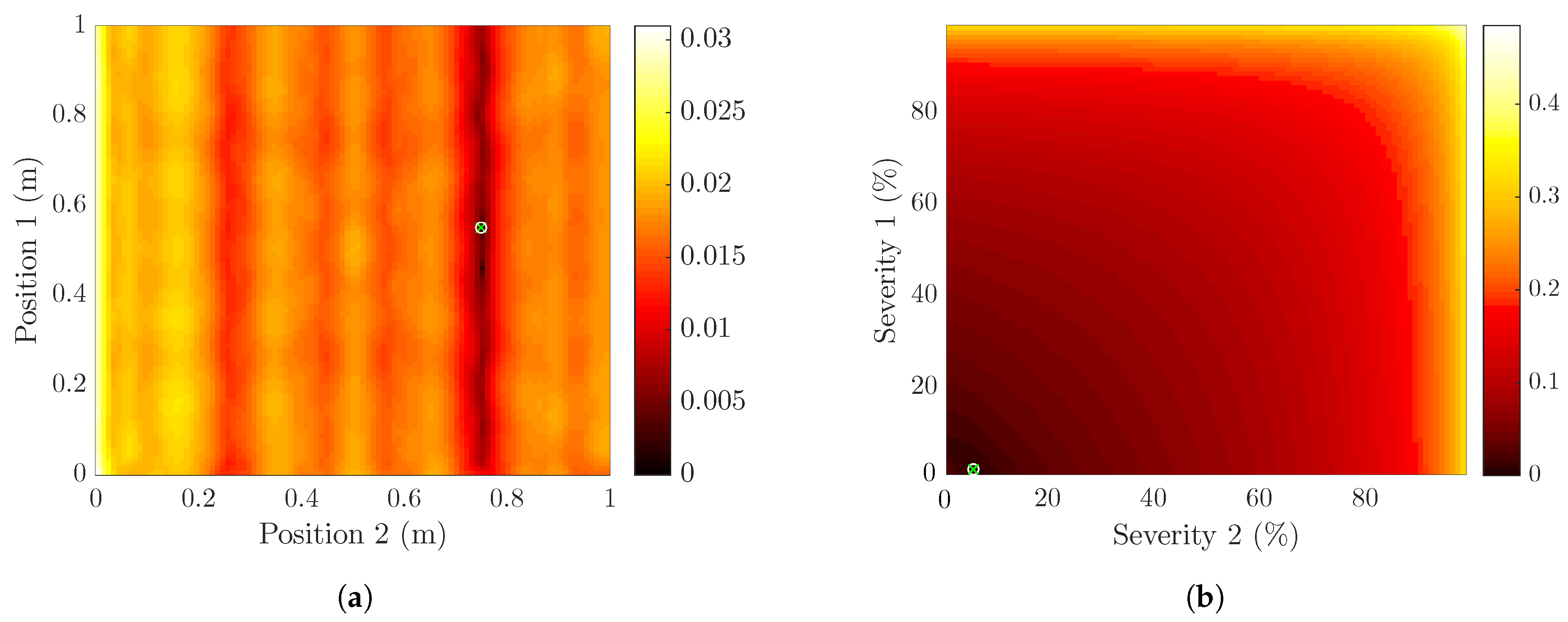


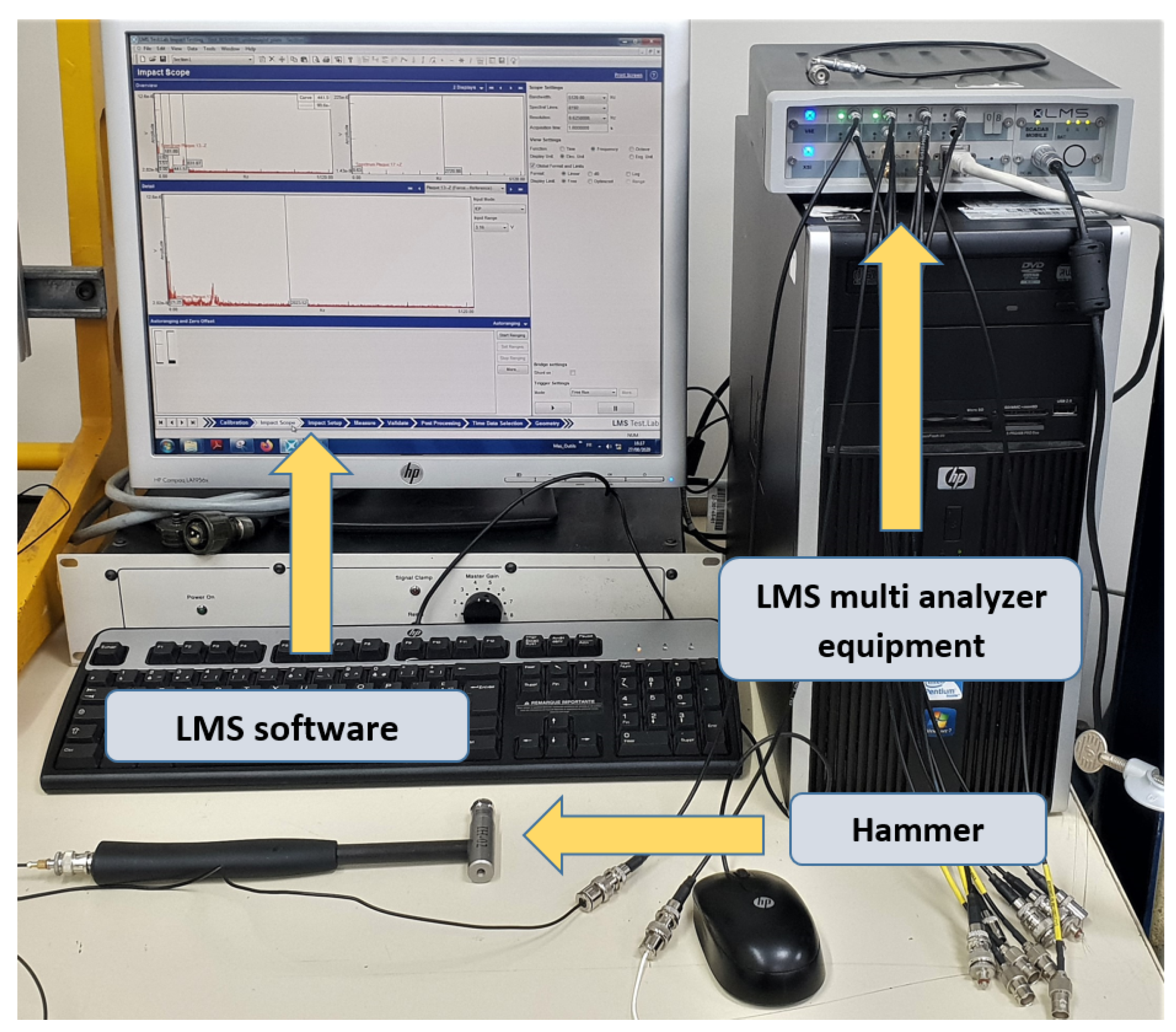
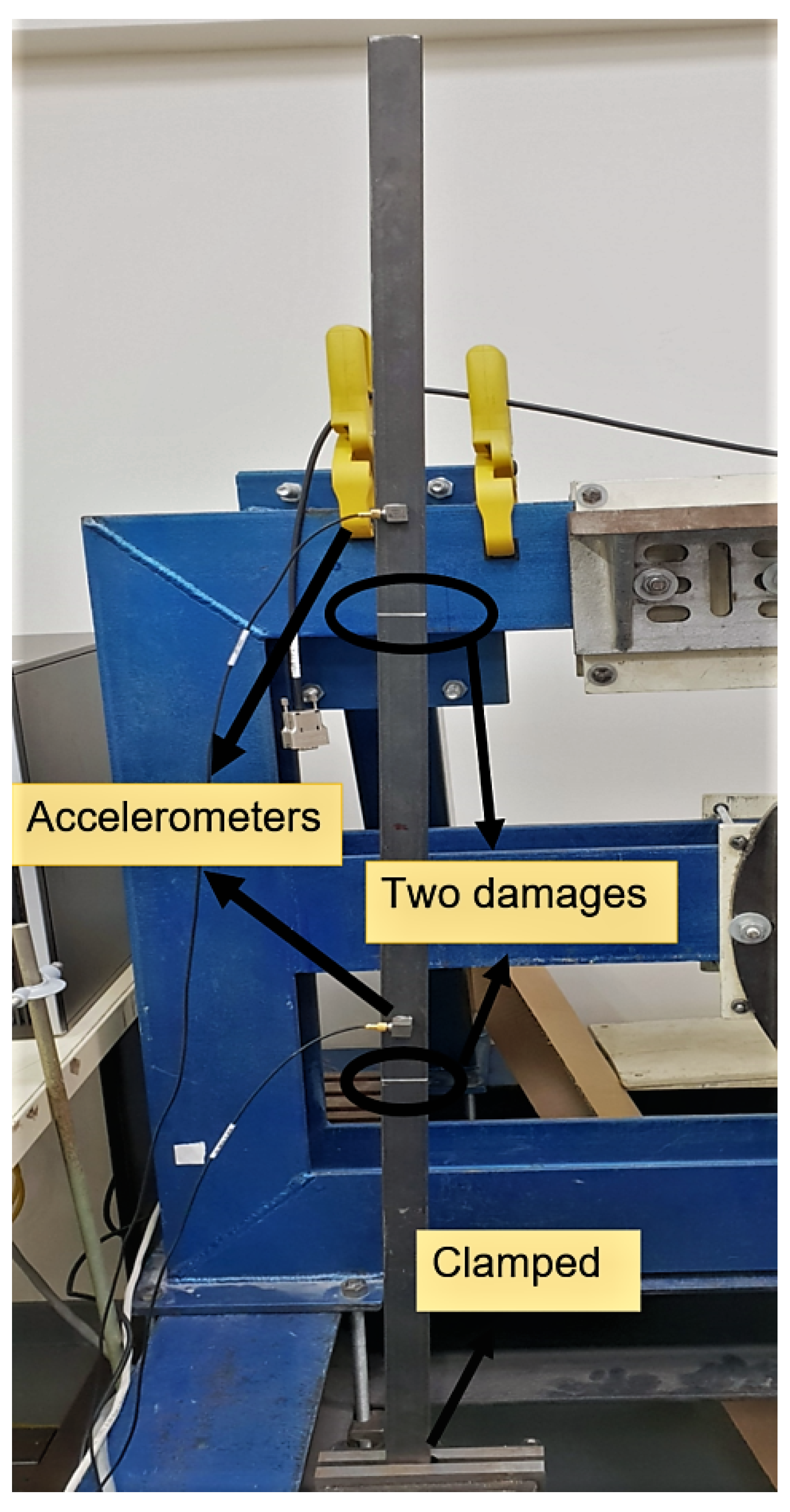
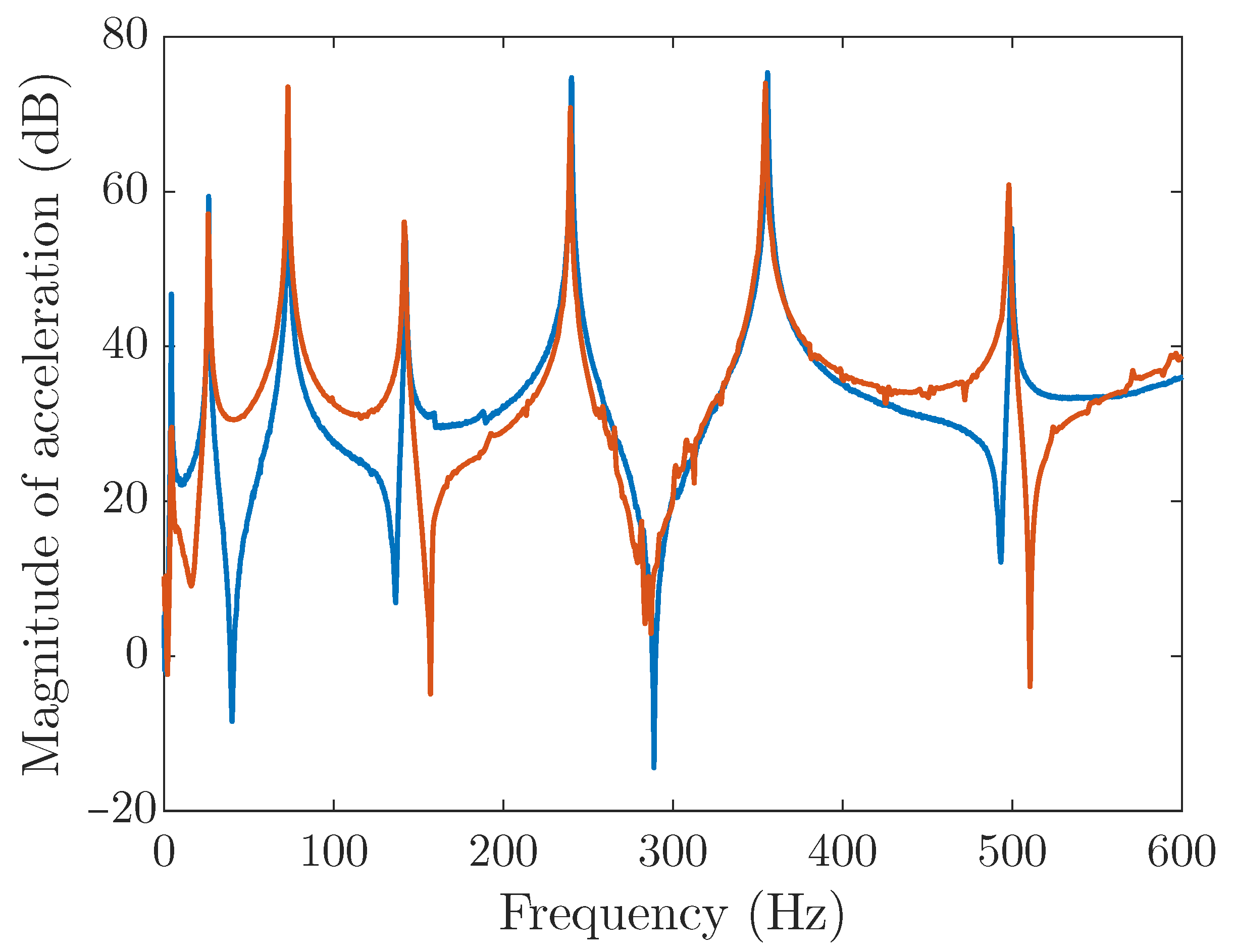
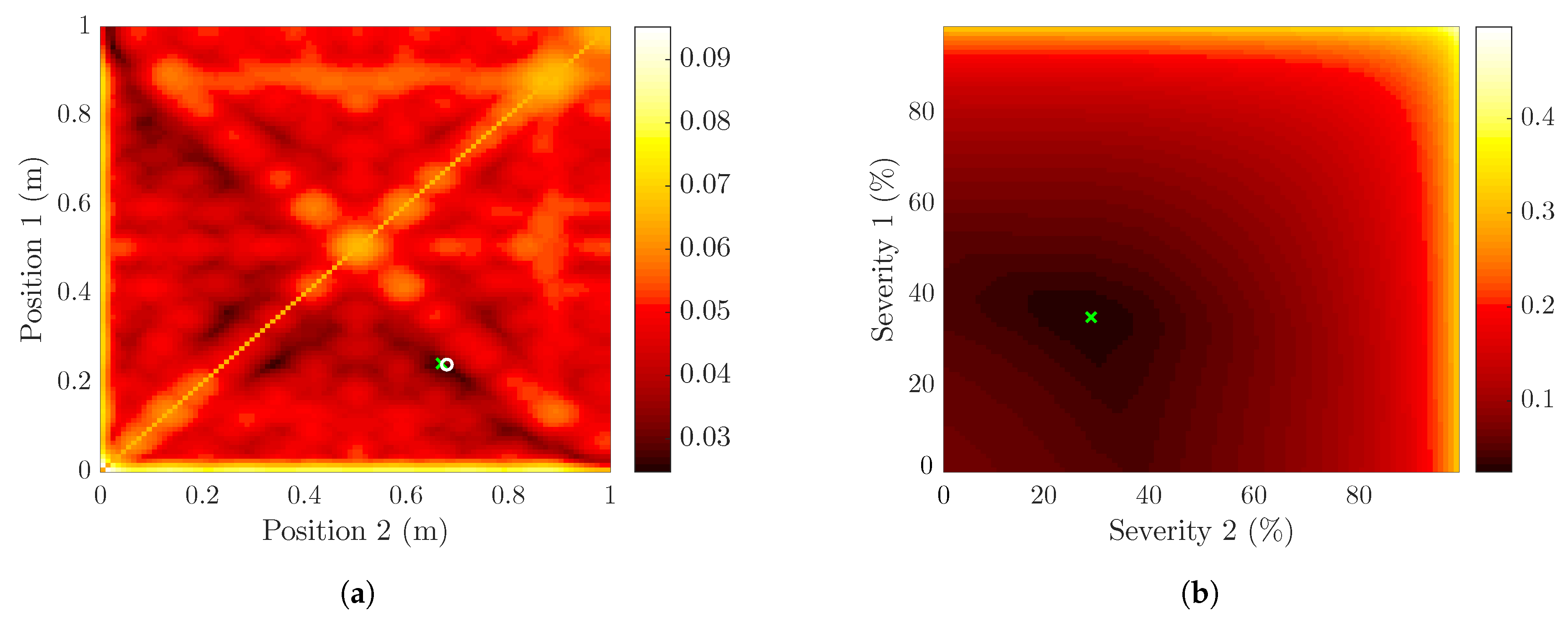
| Beam Properties | Value |
|---|---|
| Length (L) | 1000 |
| Width (W) | 25 |
| Thickness (T) | 5.4 mm |
| Young’s modulus (E) | 210 GPa |
| Poisson’s ratio (v) | 0.33 |
| Mass density () | 7850 |
| Healthy Beam | Natural Frequencies (Hz) | ||||||
|---|---|---|---|---|---|---|---|
| 1 | 2 | 3 | 4 | 5 | 6 | 7 | |
| Experimental | 4.27 | 26.33 | 73.26 | 142.34 | 240.12 | 355.66 | 499.66 |
| 2D FE Model (updated E = 189.26 GPa) | 4.20 | 26.35 | 73.77 | 144.56 | 238.96 | 356.97 | 498.57 |
| Errors (%) | 0.70 | 0.08 | 0.69 | 1.54 | 0.49 | 0.36 | 0.22 |
| Damaged Cases | Natural Frequencies (Hz) | ||||||
|---|---|---|---|---|---|---|---|
| 1 | 2 | 3 | 4 | 5 | 6 | 7 | |
| (a) 0.15 m, 2% | 4.20 | 26.34 | 73.77 | 144.55 | 238.92 | 356.90 | 498.51 |
| (b) 0.25 m, 15% | 4.20 | 26.34 | 73.68 | 144.35 | 238.88 | 356.90 | 497.89 |
| (c) 0.65 m, 8% | 4.20 | 26.35 | 73.73 | 144.46 | 238.92 | 356.93 | 498.23 |
| (d) 0.80 m, 24% | 4.20 | 26.33 | 73.59 | 144.04 | 238.37 | 356.79 | 492.47 |
| Damaged Cases | Natural Frequencies (Hz) | ||||||
|---|---|---|---|---|---|---|---|
| 1 | 2 | 3 | 4 | 5 | 6 | 7 | |
| (a) 0.24 m, 3%, | |||||||
| 0.82 m, 5% | 4.20 | 26.34 | 73.73 | 144.43 | 238.81 | 356.87 | 498.47 |
| (b) 0.60 m, 30%, | |||||||
| 0.90 m, 17% | 4.20 | 26.24 | 73.59 | 144.30 | 237.70 | 356.27 | 495.61 |
| (c) 0.34 m, 9%, | |||||||
| 0.44 m, 4% | 4.20 | 26.33 | 73.70 | 144.51 | 238.77 | 356.61 | 498.35 |
| (d) 0.55 m, 1%, | |||||||
| 0.75 m, 6% | 4.20 | 26.34 | 73.72 | 144.46 | 238.93 | 356.90 | 498.25 |
| Damaged Cases | Natural Frequencies (Hz) | ||||||
|---|---|---|---|---|---|---|---|
| 1 | 2 | 3 | 4 | 5 | 6 | 7 | |
| (a) 0.30 m, 40% | 4.18 | 26.31 | 73.35 | 144.21 | 238.86 | 354.98 | 496.20 |
| (b) 0.50 m, 50% | 4.19 | 26.08 | 73.77 | 143.16 | 238.94 | 353.60 | 498.51 |
| Experimental Beam | Natural Frequencies (Hz) | ||||||
|---|---|---|---|---|---|---|---|
| 1 | 2 | 3 | 4 | 5 | 6 | 7 | |
| 4.27 | 26.33 | 73.26 | 142.34 | 240.13 | 355.67 | 499.66 | |
| 4.25 | 26.22 | 72.82 | 141.73 | 239.38 | 354.36 | 497.97 | |
Publisher’s Note: MDPI stays neutral with regard to jurisdictional claims in published maps and institutional affiliations. |
© 2022 by the authors. Licensee MDPI, Basel, Switzerland. This article is an open access article distributed under the terms and conditions of the Creative Commons Attribution (CC BY) license (https://creativecommons.org/licenses/by/4.0/).
Share and Cite
Dubey, A.; Denis, V.; Serra, R. Sensitivity and Efficiency of the Frequency Shift Coefficient Based on the Damage Identification Algorithm: Modeling Uncertainty on Natural Frequencies. Vibration 2022, 5, 59-79. https://doi.org/10.3390/vibration5010003
Dubey A, Denis V, Serra R. Sensitivity and Efficiency of the Frequency Shift Coefficient Based on the Damage Identification Algorithm: Modeling Uncertainty on Natural Frequencies. Vibration. 2022; 5(1):59-79. https://doi.org/10.3390/vibration5010003
Chicago/Turabian StyleDubey, Anurag, Vivien Denis, and Roger Serra. 2022. "Sensitivity and Efficiency of the Frequency Shift Coefficient Based on the Damage Identification Algorithm: Modeling Uncertainty on Natural Frequencies" Vibration 5, no. 1: 59-79. https://doi.org/10.3390/vibration5010003
APA StyleDubey, A., Denis, V., & Serra, R. (2022). Sensitivity and Efficiency of the Frequency Shift Coefficient Based on the Damage Identification Algorithm: Modeling Uncertainty on Natural Frequencies. Vibration, 5(1), 59-79. https://doi.org/10.3390/vibration5010003








